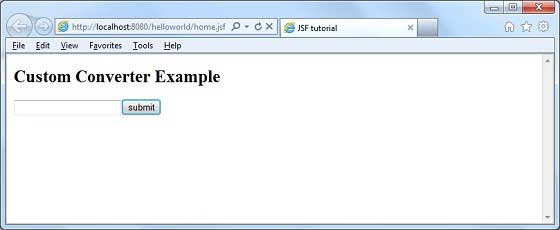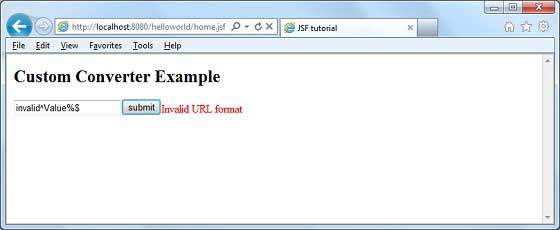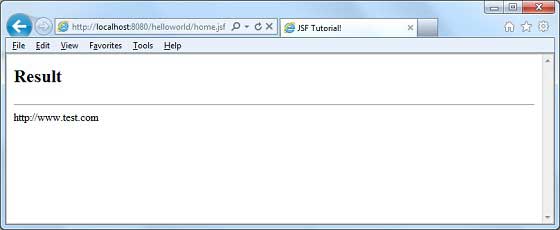
- JSF - Home
- JSF - Overview
- JSF - Environment Setup
- JSF - Architecture
- JSF - Life Cycle
- JSF - First Application
- JSF - Managed Beans
- JSF - Page Navigation
- JSF - Basic Tags
- JSF - Facelet Tags
- JSF - Convertor Tags
- JSF - Validator Tags
- JSF - DataTable
- JSF - Composite Components
- JSF - Ajax
- JSF - Event Handling
- JSF - JDBC Integration
- JSF - Spring Integration
- JSF - Expression Language
- JSF - Internationalization
JSF - Custom Converter
We can create our own Custom convertor in JSF.
Defining a custom converter in JSF is a three-step process.
| Step | Description |
|---|---|
| 1 | Create a converter class by implementing javax.faces.convert.Converter interface. |
| 2 | Implement getAsObject() and getAsString() methods of above interface. |
| 3 | Use Annotation @FacesConvertor to assign a unique id to the custom convertor. |
Step 1: Create a Converter Class : UrlConverter.java
public class UrlConverter implements Converter {
...
}
Step 2: Implement Converter Interface Methods : UrlConverter.java
Create a simple class to store data: UrlData. This class will store a URL string.
public class UrlData {
private String url;
public UrlData(String url) {
this.url = url;
}
...
}
Use UrlData in getAsObject method.
public class UrlConverter implements Converter {
@Override
public Object getAsObject(FacesContext facesContext,
UIComponent component, String value) {
...
UrlData urlData = new UrlData(url.toString());
return urlData;
}
@Override
public String getAsString(FacesContext facesContext,
UIComponent component, Object value) {
return value.toString();
}
}
Step 3: Annotate to Register the Convertor : UrlConverter.java
@FacesConverter("com.tutorialspoint.test.UrlConverter")
public class UrlConverter implements Converter {
}
Use the Convertor in JSF Page
<h:inputText id = "urlInput" value = "#{userData.data}" label = "URL" >
<f:converter converterId = "com.tutorialspoint.test.UrlConverter" />
</h:inputText>
Example Application
Let us create a test JSF application to test the above tag.
| Step | Description |
|---|---|
| 1 | Create a project with a name helloworld under a package com.tutorialspoint.test as explained in the JSF - First Application chapter. |
| 2 | Create UrlData.java under package com.tutorialspoint.test as explained below. |
| 3 | Create UrlConvertor.java as a converter under package com.tutorialspoint.test as explained below. |
| 4 | Create UserData.java as a managed bean under package com.tutorialspoint.test as explained below. |
| 5 | Modify home.xhtml as explained below. Keep rest of the files unchanged. |
| 6 | Create result.xhtml in the webapps directory as explained below. |
| 7 | Compile and run the application to make sure the business logic is working as per the requirements. |
| 8 | Finally, build the application in the form of war file and deploy it in Apache Tomcat Webserver. |
| 9 | Launch your web application using appropriate URL as explained below in the last step. |
UrlData.java
package com.tutorialspoint.test;
public class UrlData {
private String url;
public UrlData(String url) {
this.url = url;
}
public String getUrl() {
return url;
}
public void setUrl(String url) {
this.url = url;
}
public String toString() {
return url;
}
}
UrlConvertor.java
package com.tutorialspoint.test;
import java.net.URI;
import java.net.URISyntaxException;
import javax.faces.application.FacesMessage;
import javax.faces.component.UIComponent;
import javax.faces.context.FacesContext;
import javax.faces.convert.Converter;
import javax.faces.convert.ConverterException;
import javax.faces.convert.FacesConverter;
@FacesConverter("com.tutorialspoint.test.UrlConverter")
public class UrlConverter implements Converter {
@Override
public Object getAsObject(FacesContext facesContext,
UIComponent component, String value) {
StringBuilder url = new StringBuilder();
if(!value.startsWith("http://", 0)) {
url.append("http://");
}
url.append(value);
try {
new URI(url.toString());
} catch (URISyntaxException e) {
FacesMessage msg = new FacesMessage("Error converting URL",
"Invalid URL format");
msg.setSeverity(FacesMessage.SEVERITY_ERROR);
throw new ConverterException(msg);
}
UrlData urlData = new UrlData(url.toString());
return urlData;
}
@Override
public String getAsString(FacesContext facesContext,
UIComponent component, Object value) {
return value.toString();
}
}
UserData.java
package com.tutorialspoint.test;
import java.io.Serializable;
import javax.faces.bean.ManagedBean;
import javax.faces.bean.SessionScoped;
@ManagedBean(name = "userData", eager = true)
@SessionScoped
public class UserData implements Serializable {
private static final long serialVersionUID = 1L;
public UrlData data;
public UrlData getData() {
return data;
}
public void setData(UrlData data) {
this.data = data;
}
}
home.xhtml
<?xml version = "1.0" encoding = "UTF-8"?>
<!DOCTYPE html PUBLIC "-//W3C//DTD XHTML 1.0 Transitional//EN"
"http://www.w3.org/TR/xhtml1/DTD/xhtml1-transitional.dtd">
<html xmlns = "http://www.w3.org/1999/xhtml"
xmlns:h = "http://java.sun.com/jsf/html"
xmlns:f = "http://java.sun.com/jsf/core">
<h:head>
<title>JSF tutorial</title>
</h:head>
<h:body>
<h2>Custom Converter Example</h2>
<h:form>
<h:inputText id = "urlInput" value = "#{userData.data}"
label = "URL" >
<f:converter converterId = "com.tutorialspoint.test.UrlConverter" />
</h:inputText>
<h:commandButton value = "submit" action = "result"/>
<h:message for = "urlInput" style = "color:red" />
</h:form>
</h:body>
</html>
result.xhtml
<?xml version = "1.0" encoding = "UTF-8"?>
<!DOCTYPE html PUBLIC "-//W3C//DTD XHTML 1.0 Transitional//EN"
"http://www.w3.org/TR/xhtml1/DTD/xhtml1-transitional.dtd">
<html xmlns = "http://www.w3.org/1999/xhtml"
xmlns:f = "http://java.sun.com/jsf/core"
xmlns:h = "http://java.sun.com/jsf/html"
xmlns:ui = "http://java.sun.com/jsf/facelets">
<h:body>
<h2>Result</h2>
<hr />
#{userData.data}
</h:body>
</html>
Once you are ready with all the changes done, let us compile and run the application as we did in JSF - First Application chapter. If everything is fine with your application, this will produce the following result.

Enter any invalid value and press Submit button. See the following error message.

Enter any valid value and press Submit button. See the following result.

jsf_convertor_tags.htm
Advertisements